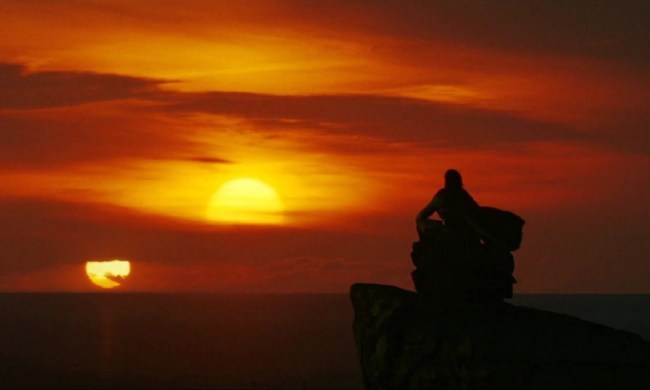The Star Trek franchise has always touted its aim to “boldly go” where no one has gone before and, by and large, it has done an impressive job of living up to that promise over 50 years of television series, movies, video games, and comic books.
JJ Abrams’ 2009 reboot broke new ground by telling a fresh story and a new action-packed continuity for the franchise, only to fall back on familiar themes in 2013’s Star Trek Into Darkness, which effectively recycled the plot of Star Trek II: The Wrath of Khan. Now, with Abrams’ exit and the arrival of Fast and Furious franchise director Justin Lin, Star Trek Beyond steers toward new territory once again — but will audiences like where it’s headed?
Directed by Lin from a script penned by Doug Jung (Dark Blue) and Simon Pegg (who plays Montgomery “Scotty” Scott in the film), Star Trek Beyond has Chris Pine’s ever-confident James T. Kirk and the USS Enterprise crew investigating an incident in uncharted space, only to be ambushed by the deadly alien Krall (as played by Emmy-nominated Luther star Idris Elba) and stranded on a wild, dangerous planet.
Fundamentally, Beyond is a very different kind of Star Trek adventure. Although it starts off slow, it doesn’t take long for Lin’s action-friendly sensibilities to take over. Filled with fast-paced sequences, fantastic set pieces, and an impressive amount of destruction, the film quickly establishes itself as the most frantic Star Trek film so far, hurtling from one life-threatening scenario to the next with only the occasional pause to catch its breath. Its frenetic pace doesn’t lend itself to much character development, but after two films in the current run and 12 films overall, Beyond assumes audiences know everything they need to know about the characters.
In Beyond, Lin’s fast, furious knack for creating cheer-worthy spectacle is on full display, and he clearly revels in the grand scope that Beyond offers him as a filmmaker. Whether the camera is chronicling a deep-space battle or a high-speed pursuit through the underbelly of a giant space station, Lin manages to find the sweet spot between his characters’ interactions with each other and the sheer madness of what’s going on around them.
The returning cast all seem more than comfortable slipping back into their roles as the crew of the famous starship, and with each installment of the franchise they feel a little less like younger replacements for William Shatner, Leonard Nimoy, and the rest of the classic Star Trek cast and more like the established, modern faces of their iconic characters. Sadly, the specter of actor Anton Yelchin’s recent death looms large over the film. Yelchin, whose character Chekov plays a notably expanded role in Beyond compared to the last two films, serves as a stark reminder of what the franchise lost when he died.
Beyond is a very different kind of Star Trek adventure.
The returning cast of characters is augmented by newcomer Jaylah, a butt-kicking alien played by Sofia Boutella. Boutella, who first caught audiences’ attention as the ruthlessly efficient killer Gazelle in Kingsman: The Secret Service, continues to justify her status as a rising star in Star Trek Beyond. She’s been given more responsibility with each role she’s taken in her short career, and her performance in Star Trek Beyond certainly doesn’t do anything to hurt her chances of playing a bigger role in her next project.
The film’s overall lack of character development takes its toll, though, especially on its villain. Maybe Lin or the writers were uncertain about how to handle Elba as Krall, but he is given far less time to develop into a memorable nemesis for Kirk and his crew. The lack of attention on Krall is particularly noticeable compared to how much time was spent building up Benedict Cumberbatch’s Khan in Into Darkness, and it’s a pity that an actor as talented as Elba isn’t given the chance to chew the scenery a bit more.
Then again, Beyond manages to be far less dreary than the last installment of the franchise.
Although it doesn’t make a huge impact on the quality of the film, Star Trek Beyond also happens to feature one of the more poorly-defined MacGuffins in Star Trek history. (It would be a spoiler to reveal exactly what it is.) The poorly-established MacGuffin is symptomatic of some of the other flaws in Beyond, and Lin occasionally relies too heavily on chaotic action sequences to distract from a thin plot that could have benefitted from more attention.

Lin is a filmmaker who excels at what he does — making things (and people) fly across the screen — and his creative team clearly played to his strengths. Star Trek Beyond could have been a mess in the hands of a lesser director, as Lin’s bombastic set pieces and the film’s special effects make up for some narrative shortcomings, and the film benefits from a straightforward script that fits his rapid-fire approach.
More than anything else, Star Trek Beyond represents a significant departure from the approach Abrams took with his take on the franchise. It proves that Star Trek can dish out action sequences as well as any sci-fi franchise, and that Star Trek feels most at home going boldly where the franchise hasn’t gone before.







